MELBOURNE CUP FEVER BUILDS …
‘Early Morning Newmarket’ Sir Alfred Munnings
The Spring Racing Carnival in Melbourne, Victoria has begun. This is a world class event with the Carnival showcasing thoroughbred racing, fashion and entertainment at its finest. The highlight of the Carnival is the Melbourne Cup, held every year on the first Tuesday in November. Known as the ‘race that stops a nation’, the Melbourne Cup Day is a public holiday in Victoria and no matter where you live or work in Australia, most people stop what they’re doing to listen to the cup. All over Australia the excitement and love of horse racing and fun can be enjoyed with office sweeps and dressing up to celebrate.
The first running of the Melbourne Cup was in 1861, and I can’t help but wonder how the race club committee would view the Melbourne Cup of today. Could they have envisaged the Cup lasting a century and a half and growing to become a significant part of our social and sporting culture. For me personally, horses and fashion are two of my passions, add a book into the equation and I would be in heaven!
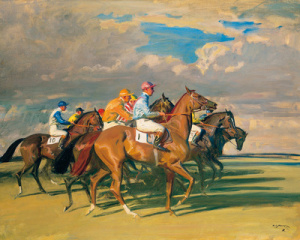
‘Lord Astors High Stakes’ – Sir Alfred Munnings
A SHORT HISTORY ON HORSE RACING
The competitive racing of horses is one of human kinds most ancient sports, having it’s origins among prehistoric nomadic tribesmen of Central Asia who first domesticated the horse in about 4500 BC. For thousands of years horse racing flourished as the sport of kings and the nobility.
By the time humans began to keep written records, horse racing was an organised sport in all major civilizations from Central Asia to the Mediterranean. Both chariot and mounted horse racing were events in the ancient Greek Olympics by 638 BC, and the sport became a public obcession in the Roman Empire.
‘Going out at Epsom’ 1929 Sir Alfred Munnings
The origins of modern racing lie in the 12th century, when English knoights returned from the Crusades with swift Arab horses. Over the next 400 years, an increasing number of Arabian stallions were imported to breed to English mares. This cross produced horses that combined speed and endurance. Matching the fastest of these animals in two-horse races for a private wager became a popular diversion of the nobility.
‘The Blue Jockey’ – Sir Alfred Munnings
Horse racing began to become a professional sport during the reign (1702-14) of Queen Anne, when match racing gave way to races involving several horses on which spectators wagered. Racecourses sprang up all over England , offering increasingly large purses to attract the best horses. These purses in turn made owning and breeding horses for racing profitable. With the rapid expansion of the sport came the need for central governing authority. In 1750 racing’s elite met at Newmarket to form the Jockey Club, which to this day exercise’s complete control over English racing.
‘Unsaddling at Epsom Summer Meeting’ Sir Alfred Munnings
In Australia Thoroughbred horse racing is an important spectator sport in Australia, and gambling on horse races is a popular pastime with A$14.3 billion wagered in 2009/10 with bookmakers and the Totalizator Agency Board (TAB). The two forms of Thoroughbred horse racing in Australia are flat racing, and races over fences or hurdles in Victoria and South Australia. Thoroughbred racing is the third most attended spectator sport in Australia, behind Australian rules football and rugby league, with almost two million admissions to 360 registered racecourses throughout Australia in 2009/10. Horse racing commenced soon after European settlement, and is now well-appointed with automatic Totalizator, starting gates and photo finish cameras on nearly all Australian racecourses.
‘Jockeys’ -Sir Alfred Munnings
On an international scale Australia has more racecourses than any other nation. It is second to the United States in the number of horses starting in races each year. Australia is third, after the U.S. and Japan for the amount of prize money that is distributed annually.
Information from www.wikipedia.org

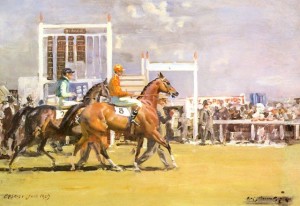
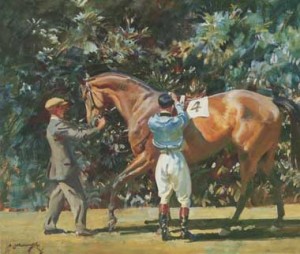
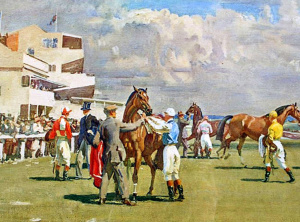
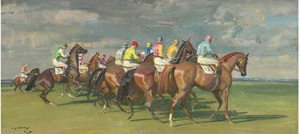
Leave a Reply